Unlock the full potential of your aerial content with advanced aerial videography techniques that can redefine the way we perceive cinematography. Professionals and enthusiasts alike are pushing the boundaries of creativity, using professional drone filming tricks to capture footage that was once out of reach. The seamless integration of high-resolution cameras, state-of-the-art gimbals, and nuanced camera settings are now the tools of the trade for those intent on mastering cinematic drone photography secrets.
Diving deeper into this realm, factors such as shutter speed, aperture, ISO, and white balance are no longer mere settings but gateways to transforming ordinary shots into stunning visual narratives. Be it through the choreographed dance of drones across the skies or the technical prowess behind each frame, advanced aerial videography isn’t just about taking flight—it’s about elevating storytelling to its zenith.
Join us as we embark on a journey to discover how harnessing these innovative techniques can turn the sky into your cinematic canvas, offering a fresh perspective that captivates audiences and sets your work apart in the world of film and video production.
Unveiling the Potential of Drone Cinematography
The landscape of filmmaking has been transformed with the advent of drones, catalyzing a shift from rudimentary aerial footage to ingenious works of cinematographic art. With the proliferation of professional drone filming tricks, the entry barrier to producing visually stunning narratives has significantly lowered. Consequently, whether for indie projects or big-budget films, the prowess of drone videography advanced skills has become indispensable.
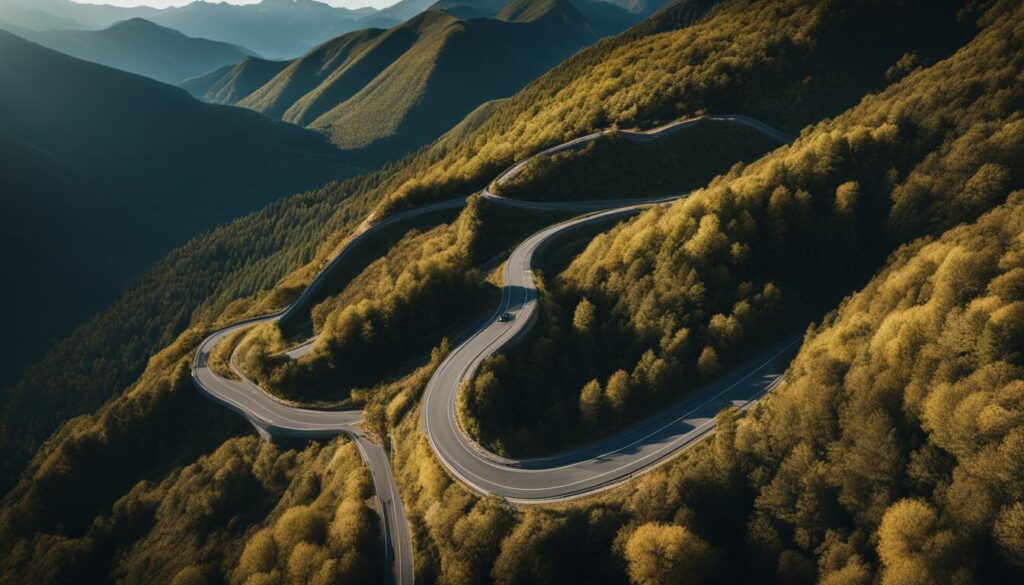
Advances in drone technology have not only broadened the horizon for creative storytelling but have also democratized the art form, empowering filmmakers to adopt expert drone shooting techniques with ease. As a testimony to this evolution, let’s delineate some advanced maneuvers that have redefined the aesthetic contours of modern cinematography:
- Dynamic Tracking Shots: Employing drones to shadow a moving subject, creating a visceral sense of motion and engaging viewers in the narrative.
- Innovative Reveals: Utilizing drones for gradually unveiling landscapes or subjects, adding a layer of suspense and panoramic majesty.
- Complex Orbiting: Perfecting the art of circular movement around a focal point to offer a comprehensive perspective, simultaneously captivating through its consistent framing and grandeur.
The trajectory from traditional techniques to cutting-edge drone operations not only enhances the visual fidelity of film productions but also introduces novel viewpoints that challenge conventional filmmaking norms. By integrating drones with cinematic ingenuity, filmmakers can unlock new dimensions of visual storytelling.
While industry stalwarts often turn to brands known for their reliability and advanced features, such as DJI or Parrot, what remains critical is the progressive mastery of the craft. For the aspiring aerial videographer, developing a repertoire of drone videography advanced skills is a journey marked by continuous learning, practice, and a passion for innovation. As we delve deeper into the capabilities of drone cinematography, the potential for breathtaking and emotionally resonant visuals becomes evidently boundless.
Advanced Aerial Videography Techniques: Raising the Bar in Filmmaking
The evolution of drone technology has redefined the boundaries of filmmaking, ushering in a new era of aerial videography. With sophisticated advancements, today’s drones offer robust camera specifications and dynamic flight capabilities that empower cinematographers to create breathtaking visuals that were once the domain of Hollywood-level productions.
Understanding Drone Capabilities and Camera Specs
In the realm of advanced aerial videography techniques, a deep comprehension of your drone’s capabilities is fundamental. High-resolution cameras that record in 4K or higher, reliable stabilization through advanced gimbal systems, and extended battery life for prolonged shooting are just the tip of the iceberg when it comes to the specifications required for professional-grade aerial cinematography. These technological advances have made intricate pans and exacting aerial compositions not just possible, but an expected standard in the film industry.
Exploring Creative Flight Patterns for Dramatic Effect
Cinematographers can leverage creative flight patterns to infuse drama and convey narrative depth. For instance, an orbit shot can spectacularly showcase a scene from multiple perspectives, while a well-executed fly-through maneuver can bring viewers intimately close to the unfolding action. These advanced aerial camera movements are enriched by both the pilot’s skill and the drone’s responsive navigation features, leading to an immersive cinematic experience.
Utilizing Advanced Camera Movements to Enhance Storytelling
Advanced aerial videography techniques are all about storytelling. By complementing narrative structures with advanced aerial camera movements, filmmakers can more precisely evoke emotions and progress the story. For example, a slow vertical ascent can unveil the scale and context of a scene, while a swift, low pass can create tension and excitement. It’s these carefully choreographed maneuvers that turn aerial footage into an art form that resonates with audiences on a deeper level.
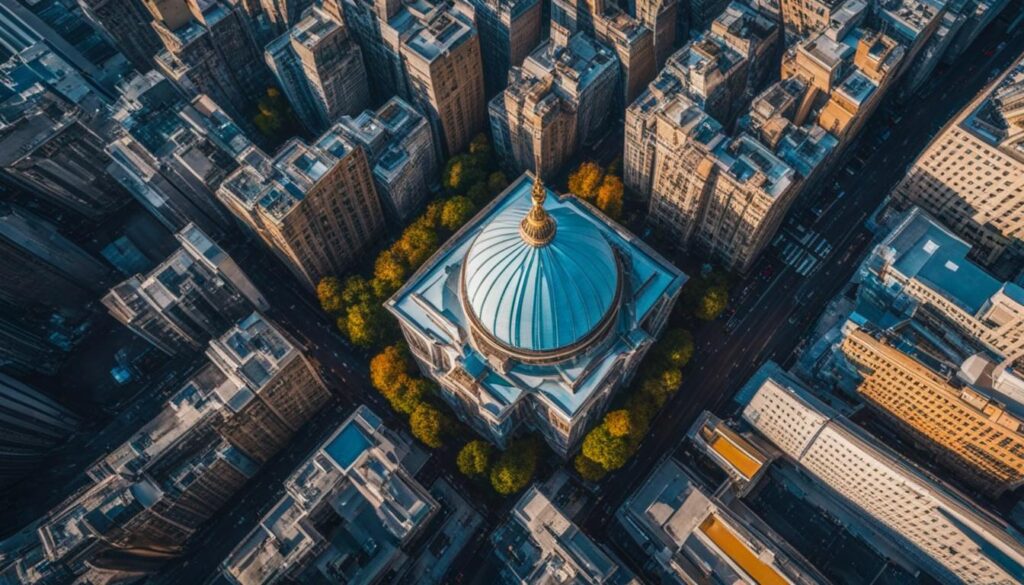
The interplay of technical precision and artistic vision revolutionizes how stories are told from above. Aspiring and professional filmmakers alike can benefit greatly from mastering these advanced techniques to create compelling, visually arresting narratives that captivate viewers and stand out in the digital landscape.
Choosing the Right Equipment for Professional Drone Filming
When it comes to elevating your craft in professional drone filming, the significance of selecting the right equipment cannot be overstated. With the surge in popularity of advanced aerial videography techniques, every component from the drone itself to the smallest accessory plays a crucial role in achieving that perfect shot. The harmonious combination of technology, skill, and creative expression is what sets apart the amateurs from the true artists in drone videography advanced skills.
Investing in a sophisticated drone that embodies high resolution and stability is at the core of advanced filmmaking. Let’s delve into the essentials that contribute to mastering professional drone filming tricks.
- Drones with High-Resolution Cameras: Incorporating drones equipped with 4K or 6K cameras enables videographers to capture crisp, detailed footage from the skies. These high-resolution cameras are imperative for producing quality content that endures professional scrutiny.
- Top-Notch Gimbal Systems: To ensure the ultimate stability and fluidity in your shots, a high-quality gimbal is key. It can make a profound difference in delivering silky smooth footage, even in the most challenging flight conditions.
- Extended Flight Capabilities: Drones that offer extended flight times and efficient battery use allow for prolonged filming sessions, enabling more footage capturing and minimizing downtime.
- Precision Positioning Features: Advanced GPS functionality is not just a luxury, but a necessity for precision positioning and stable, controlled movements, which are essential for complex videographic tasks.
All these technical specs must be backed by a selection of indispensable accessories:
- Neutral Density (ND) Filters: These are vital for manipulating light exposure, allowing for that cinematic motion blur which breathes life into your footage.
- Extra Batteries: It is always prudent to have additional batteries on hand to ensure you can keep shooting without interruption, especially during vital moments.
- Protective Transportation Cases: To safeguard your investment, specialized carrying cases are essential for transporting and protecting your gear in various environments.
By meticulously choosing the right equipment, both in terms of technology and accessories, you set a strong foundation for capturing stunning aerial visuals. Remember, professional equipment coupled with advanced skills can manifest a vision into breathtaking aerial cinematography.
Mastering Camera Settings for Optimal Aerial Footage
Acquiring advanced skills in drone videography is not only about navigating the skies but also about harnessing the power of camera settings to produce top-quality aerial imagery. In this part of the article, we delve into the technical aspects that allow for achieving cinematic drone photography secrets and demonstrate advanced aerial videography techniques.
Adjusting Shutter Speed for Desired Motion Blur
One crucial technique in achieving the desired cinematic look in your footage is controlling the shutter speed. A lower shutter speed will introduce a slight blur that mimics the human eye’s perception of movement, adding natural fluidity to your shots. Conversely, a higher shutter speed will freeze action, which can be perfect for capturing still images of fast-moving subjects without loss of detail.
Manipulating Aperture to Control Field Depth
The choice of aperture has a profound impact on the depth of field and the overall sharpness of the image. A smaller f-stop number (larger aperture) brings more light into the sensor, ideal for low-light conditions and achieving a shallow depth of field that emphasizes the subject against a soft, blurred background.
Setting ISO for Perfect Lighting Conditions
ISO adjustment plays an indispensable role in compensating for the ambient lighting conditions. A higher ISO enables the camera to capture images in darker environments, while a lower ISO is optimal for bright scenes to avoid overexposure and maintain the fine grain and clarity essential in professional drone footage.
White Balance Adjustments for True-to-Life Colors
With drones soaring high and capturing expansive environments, white balance becomes vital in maintaining the authenticity of the scene’s colors. Adjusting the white balance ensures that the colors are as true to life as possible, regardless of varying light sources that can cast different hues on your footage.
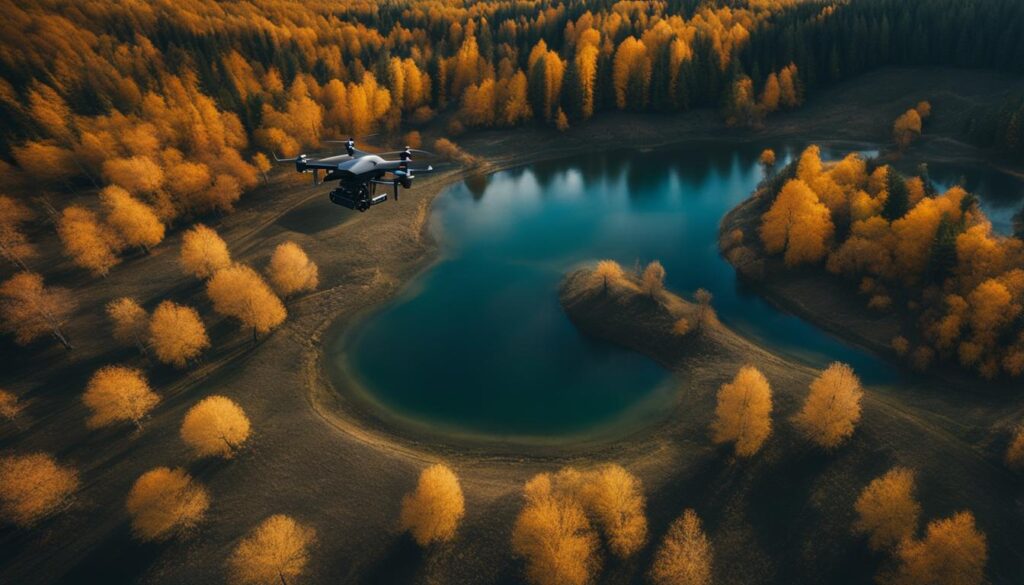
Let’s consider a practical scenario with the settings elaborated in a comprehensive table:
| Condition | Shutter Speed | Aperture | ISO | White Balance |
|---|---|---|---|---|
| Bright Daylight | 1/1000 | f/5.6 | 100 | Daylight |
| Golden Hour | 1/500 | f/4 | 400 | Golden Hour |
| Overcast Sky | 1/250 | f/3.5 | 800 | Cloudy |
| Night Time | 1/50 | f/2.8 | 3200 | Incandescent |
Through meticulous manipulation of these settings, drone enthusiasts can realize their vision for cinematic drone photography, crafting footage with deft skill and a deeper understanding of what their equipment can achieve.
Drone Flight Patterns and Their Cinematic Impact
The art of filmmaking has long embraced the creative possibilities of aerial cinematography. With the advent of more accessible and advanced drone technology, filmmakers are able to incorporate expert drone shooting techniques that add unparalleled depth and dynamism to their narratives. To truly harness the potential of drone capabilities, understanding the variety of aerial photography maneuvers is crucial, as each technique carries its own cinematic weight and storytelling power.
Advanced drone operators employ advanced aerial videography techniques that transform simple scenes into visually arresting moments. For instance, an orbit shot can circle a subject creating a dramatic reveal or a sense of motion, while a crane shot simulates the vertical motion of traditional crane equipment, offering a grand entrance or exit for the subject in view. A filmmaker’s proficiency in these advanced techniques often marks the difference between amateur footage and professional-grade storytelling.
| Flight Pattern | Cinematic Impact |
|---|---|
| Orbit | Engages audience with dramatic, circular perspective around subjects |
| Crane | Mimics a rise or descent, offering an expanding or narrowing viewpoint |
| Tracking | Follows alongside the subject, maintaining focus while revealing context |
| Reveal | Starts with a hidden subject and unfolds the scene to show the broader picture |
| Reverse | Draws away from the subject, often used to conclude a scene or provide reflection |
Each drone flight pattern offers a unique palette for visual storytelling, allowing the capture of scenes that would otherwise be unattainable. When expertly executed, these maneuvers can elicit strong reactions from the audience, making the footage not just a component of the narrative, but a character in itself. It’s through these expert motions and sweeps that the landscape of aerial cinematography continues to expand, enriching the craft of filmmaking.
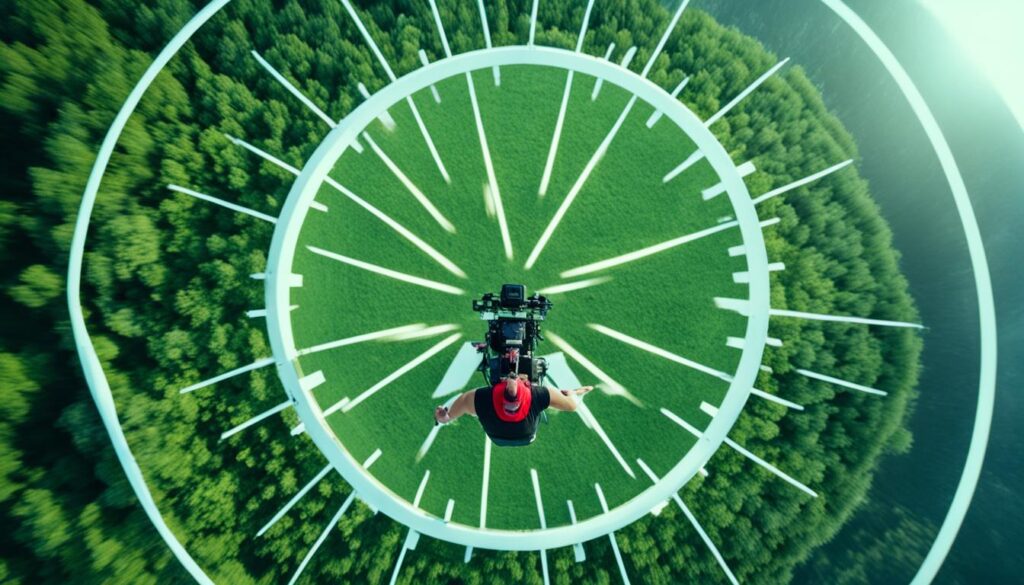
Ultimately, the impact of these maneuvers goes beyond the visual—it connects with viewers on an emotional level, increasing engagement and leaving a lasting impression. The ability to effectively combine these flight patterns with storytelling is what sets apart proficient filmmakers who are committed to pushing the frontiers of advanced aerial videography techniques and creating truly cinematic experiences.
Composition Techniques for Cinematic Drone Photography
Delving into the world of cinematic drone photography requires more than just a keen eye for breathtaking landscapes; it demands a mastery of composition techniques that transform simple aerial shots into extraordinary works of art. Tapping into these compositional strategies allows photographers to unveil the cinematic drone photography secrets that are fundamental in crafting visually compelling content. In this section, we will explore pivotal tips for expert drone shooting techniques and invaluable aerial cinematography tips, enhancing the overall impact of your aerial imagery.
Incorporating Foreground Elements for Depth
Foreground elements are essential for adding depth and context to aerial photographs. By strategically placing objects in the foreground of the frame, drones can capture layers within a scene, facilitating a three-dimensional perspective that draws viewers into the image. This technique embellishes the perception of distance and scale, ensuring that each composition is rich with depth and dimension.
Implementing Symmetry and Patterns for Visual Appeal
Symmetry and patterns hold the power to mesmerize viewers, offering a sense of balance and harmony that is universally appealing. Drone photographers can harness this power by seeking out these geometric delights from an aerial viewpoint. The unique vantage point of a drone turns the mundane into the magnificent, highlighting the visual appeal that symmetry and patterns contribute to a composition.
Maximizing the Rule of Thirds for Balanced Footage
The Rule of Thirds is a foundational principle in photographic composition, especially relevant in the context of drone photography. By dividing the image into thirds, both horizontally and vertically, and placing the subject at the intersection of these lines, you create a balanced, engaging frame that naturally draws the eye to the most important elements of the scene.
| Composition Technique | Description | Visual Impact |
|---|---|---|
| Foreground Elements | Adds depth by layering the scene | Creates a three-dimensional experience for the viewer |
| Symmetry and Patterns | Finds balance and repetition from a unique aerial view | Provides mesmerizing and engaging visuals |
| Rule of Thirds | Divides the frame for balanced composition | Ensures a natural flow and focus within the image |
Advanced Maneuvers for Standout Aerial Videography
Incorporating advanced aerial camera movements into your repertoire as a drone cinematographer can transform an ordinary scene into a spectacular visual narrative. Techniques such as the parallax effect and dolly zoom have become essential tools in the arsenal of filmmakers who strive to produce work that not only tells a story but does so with an engaging and technically accomplished visual flair.
The parallax effect creates a mesmerizing depth by moving the drone laterally while maintaining the focus on the subject, allowing the background to move at a different speed than the foreground. This juxtaposition results in a heightened sense of realism and cinematic quality. On the other hand, the dolly zoom—when executed with a drone—shifts the viewer’s perspective in a way that ground-based equipment simply cannot match. It’s these aerial photography maneuvers that impress upon audiences the sophistication of advanced aerial videography techniques.
Let’s explore some of the advanced maneuvers that can help your aerial footage stand out:
- Parallax Effect: Enriches visual interest and depth by moving sideways with respect to the subject.
- Dolly Zoom: Alters the viewer’s perception of space for a dramatic and surreal effect.
- Orbiting: Circling around a subject to showcase it from multiple perspectives.
- Reveal Shots: Beguiling the audience with a progressive scene unveiling.
To further illustrate the comparison between these dynamic maneuvers, consider the following table which delves into the nuances of each, providing you with insight on when and how to best deploy these techniques:
| Maneuver | Purpose | Ideal Use |
|---|---|---|
| Parallax Effect | To add depth and dynamic interest | Lateral movements around subjects with pronounced backgrounds |
| Dolly Zoom | To create a vertigo effect that distorts spatial perception | Intense emotional moments requiring a perceptual shift |
| Orbiting | To show a 360-degree perspective around the subject | Narrative storytelling, establishing geographic context |
| Reveal Shots | Slow reveal of landscapes or objects for suspense or interest | Introducing viewers to new scenes or subjects |
Mastery of these advanced aerial videography techniques not only sets the stage for innovative storytelling but also stamps one’s mark as a filmmaker with a compelling visual signature. These maneuvers, when executed deftly, can captivate an audience, elevating the aesthetic quality of the footage and, by extension, the entire cinematic piece.
Improving Aerial Shots with Post-Production Enhancements
The journey of producing mesmerizing aerial content doesn’t end once the drone returns to the ground; in fact, it’s within the post-production suite that the footage attains its final form of excellence. With **advanced aerial videography techniques**, the editing process is just as pivotal as the flight itself. Through meticulous post-production enhancements, even the most seasoned drone cinematographers can elevate their output, transforming raw clips into a cohesive and emotionally resonant narrative.
Color Grading Techniques for Mood and Tone
Color grading is an artistic cornerstone for setting the right mood and infusing tone into drone footage. It’s not just about aesthetics; it’s about storytelling. Manipulating hues, saturation levels, and contrasts enable filmmakers to subtly guide the viewer’s emotional response to each frame. Applying color theory and grading skills gleaned from **cinematic drone photography secrets** ensures the final piece is not just seen but felt, evoking the intended atmosphere that complements the visual tale.
Stabilization and Noise Reduction for Pristine Quality
Even with the steadiest drones and most skilful flying, unexpected turbulence or sensor noise can introduce unwelcome jitters and grain into the footage. Enter stabilization and noise reduction: the unsung heroes of **post-production enhancements**. These processes are vital for achieving the pristine quality expected in professional-grade footage, scrubbing away the rough edges and presenting a polished end product that boasts both clarity and fluidity of motion.
Advanced Editing Software for Drones
Leveraging the capabilities of advanced editing software tailored for drone footage can make a world of difference. From intricate clipping and sequencing to adding visual effects that enhance the story, the right tools empower creators to unveil their vision down to the finest detail. Whether it’s dynamically adjusting frame rates or creatively stitching together panoramic vistas, complex editing suites become a playground for innovation and artistry in the realm of advanced aerial videography.
FAQ
Q: What are some advanced aerial videography techniques?
A: Advanced aerial videography techniques include implementing dynamic shots with smooth camera movements, understanding key camera settings for optimal footage, mastering creative flight patterns (like orbiting and tracking shots), and utilizing maneuvers such as the parallax effect and dolly zoom. Accessories such as ND filters also play a key role.
Q: How has drone cinematography changed professional filmmaking?
A: Drone cinematography offers an innovative perspective by providing unique storytelling capabilities through advanced flight patterns and camera movements. It has allowed filmmakers to capture dramatic, high-resolution aerial shots that were once impossible, adding depth and drama to narrative storytelling.
Q: What should I consider when choosing equipment for professional drone filming?
A: Key considerations for professional drone filming include selecting drones with high-resolution cameras, reliable gimbals for stabilization, extended flight times, advanced GPS features, and necessary accessories like ND filters, extra batteries, and proper protective cases.
Q: How can I master camera settings to improve my drone footage?
A: To master camera settings for drone footage, familiarize yourself with adjusting shutter speed for motion blur, setting the aperture for the desired depth of field, tweaking ISO for perfect lighting, and making white balance adjustments to ensure accurate color representation in different lighting conditions.
Q: What are some cinematic flight patterns used in drone videography?
A: Cinematic flight patterns include orbiting around subjects, tracking alongside or behind dynamic subjects, and executing reveal shots that gradually uncover landscapes or objects. These patterns add a dynamic visual narrative to footage.
Q: How do composition techniques enhance cinematic drone photography?
A: Composition techniques such as incorporating foreground elements, symmetry, and patterns, and using the Rule of Thirds, can significantly enhance the visual quality of drone photography by adding interest and creating well-balanced and engaging shots.
Q: What advanced maneuvers can I use to create standout aerial videography?
A: Advanced maneuvers for standout aerial videography include the parallax effect, which involves lateral movement to create a sense of three-dimensional depth, and the dolly zoom, which alters the focal length during flight to create a disorienting spatial effect.
Q: How does post-production improve aerial video quality?
A: Post-production is essential for refining aerial footage. Techniques like color grading can effectively set the mood and tone, while stabilization and noise reduction maintain high quality. Advanced editing software for drones allows for precise cutting and creative effects, enhancing the professional finish of the footage.
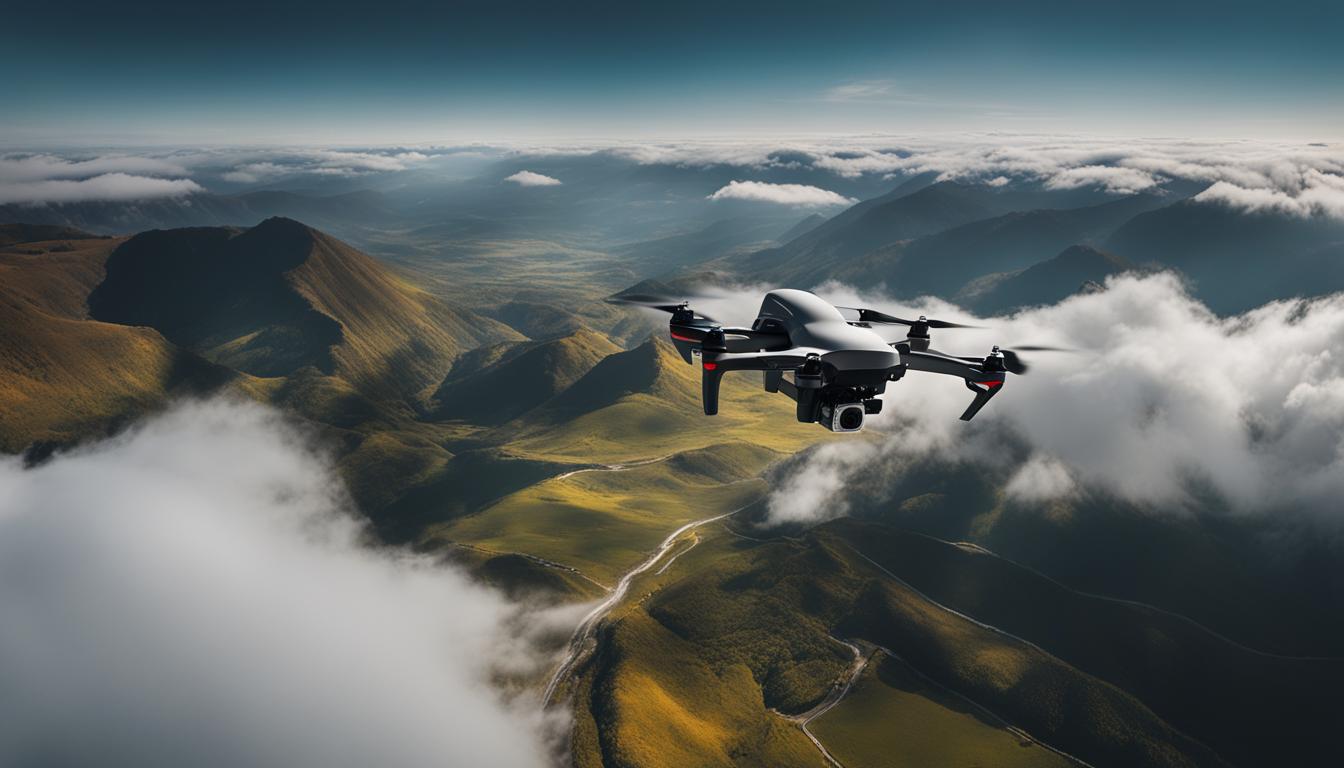
Leave a Reply